Keeping all the surfaces in your home sterilized clean 24 hours a day
even when we’re not there.
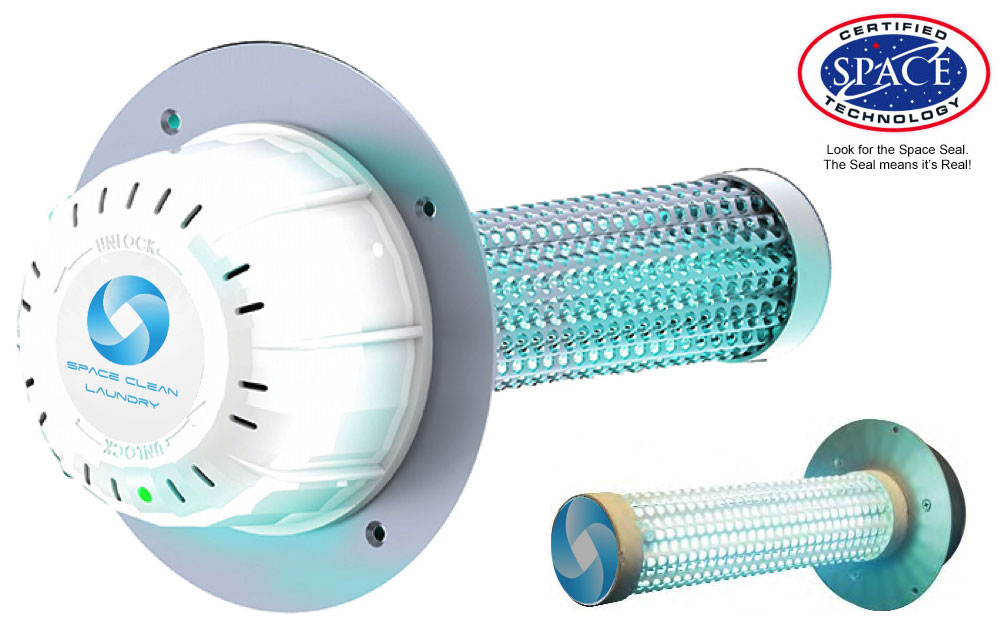 The Space Clean Technology SCT Induct 3000 System utilizes patented PHI-Cell technology and is easily mounted onto your existing air conditioning and heating system air ducts. When the HVAC system is in operation, the SCT Induct 3000 creates an advanced oxidation plasma (AOP) that is distributed through the duct system into the conditioned living space. Unlike passive air technologies, which need pollutants to pass through the unit for purification or filtration, the SCT Induct 3000 sweeps through your home actively purifying pollutants at the source. The Advanced Oxidation Plasma consists of Ionized Hydro-peroxides, Super oxide ions and Hydroxide ions. All are earth’s friendly oxidizers that are found in nature’s process of cleaning the outdoor air. “Friendly oxidizers” are oxidizers that revert back to oxygen and hydrogen after the oxidation of the pollutant. This hydrogen peroxide vapor is excellent at killing bacteria, viruses, mold, gases (VOCs), and eliminating unwanted odors.
The Space Clean Technology SCT Induct 3000 System utilizes patented PHI-Cell technology and is easily mounted onto your existing air conditioning and heating system air ducts. When the HVAC system is in operation, the SCT Induct 3000 creates an advanced oxidation plasma (AOP) that is distributed through the duct system into the conditioned living space. Unlike passive air technologies, which need pollutants to pass through the unit for purification or filtration, the SCT Induct 3000 sweeps through your home actively purifying pollutants at the source. The Advanced Oxidation Plasma consists of Ionized Hydro-peroxides, Super oxide ions and Hydroxide ions. All are earth’s friendly oxidizers that are found in nature’s process of cleaning the outdoor air. “Friendly oxidizers” are oxidizers that revert back to oxygen and hydrogen after the oxidation of the pollutant. This hydrogen peroxide vapor is excellent at killing bacteria, viruses, mold, gases (VOCs), and eliminating unwanted odors.
Hydro-peroxides have been a common part of our environment for over 3.5 billion years. They are created in our atmosphere whenever Oxygen molecules, water vapor and energy (electro-magnetic) are present. Ionized-hydro-peroxides are very effective at destroying harmful microbials in the air and on surfaces. As oxidants, they do this by either destroying the microbe through a process known as cell lysing or by changing its molecular structure and rendering it harmless (which is the case in VOCs and odors). The amount of hydro-peroxides required to accomplish this task in a conditioned space is well below the level that is constantly in our outside air. The Advanced Oxidation Technology found in our Space Clean Technology product family has brought the oxidants found in the outside air into the conditioned space of your home.
We have been exposed to hydro-peroxides in nature since the day man stepped on the planet – it’s what you’re breathing in nature every time you walk outside – Earth’s Purifying Plasma.
Invented to recreate nature’s process of purifying the air, it’s like bringing fresh outdoor air inside without ever having to open your windows.
SPACE CLEAN TECHNOLOGY
The SCT Induct 3000:
- Reduces bacteria, mold, viruses and odors.
- Unlike portable units that are limited to the room in which they are placed, the SCT Induct 3000 provides whole home purification.
- Easily integrated with your existing HVAC system, the unit doesn’t take away living space and operates silently.
- PHI can reduce sneeze germs by 99% by the time the sneeze has reached three feet.
- U.S. Military approved for mold reduction in field hospitals.
- U.S. and International Hospital approval for the fight against infectious disease: 99% reduction of Staph (MRSA)
- Major U.S. city school reports 20% reduction in absenteeism.
- Tested and approved by the Chinese government for protection against the deadly SARS virus.
- Approved by the USDA, FSIS, and FDA for use in food processing plants. Employed to reduce microbial contamination of food being processed.
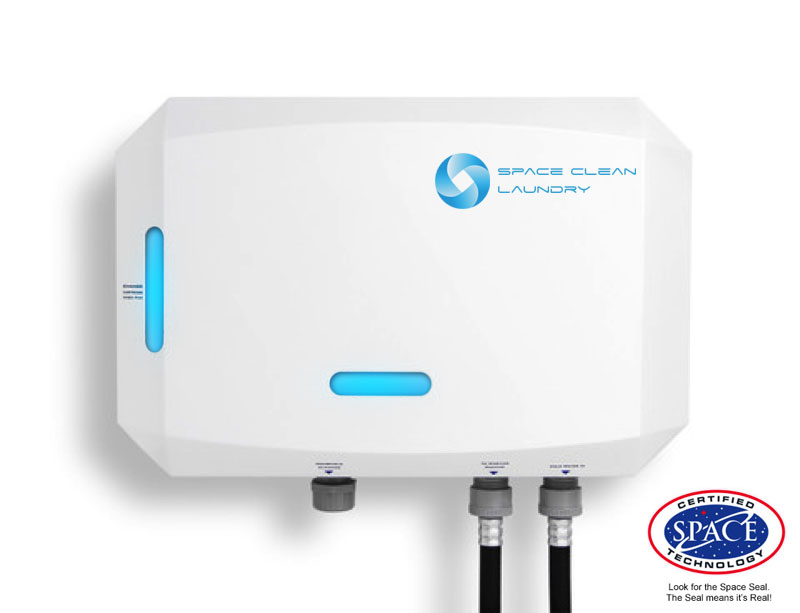 Space Clean Laundry Systems provide a 100% natural OXYGEN enriched purified wash without poisonous additives – just pure clean healthy laundry while saving our rivers, lakes and streams from detergent pollution.
Space Clean Laundry Systems provide a 100% natural OXYGEN enriched purified wash without poisonous additives – just pure clean healthy laundry while saving our rivers, lakes and streams from detergent pollution.
Home washing machines don’t create heat high enough to sterilize and detergents don’t disinfect, so the germs and bacteria that go into the machine stay there and grow, leaving nasty bacteria and toxins in your clothes, towels and bed linens – in fact, they’re probably more contaminated when they come out of the washer than before they go in.
Space Clean Laundry uses one of nature's most powerful cleaners – oxygen – to kill bacteria and mold in laundry. Your clothes, towels and bed linens will be softer, odor-free, bacteria-free and chemical-free.
This technology was developed for hospitals over 20 years ago because laundry detergents were causing so many problems for them. Laundry detergents were promoting germs, leaving behind harmful chemicals that caused irritation and infection, polluting the air, clogging drains, and reducing the life of linens. Laundry detergents were a major expense and caused so many issues that hospitals were forced to find a technology that was cheaper, more sanitary, and more environmentally-friendly.
Space Clean Laundry pays for itself quickly and then begins putting extra cash in your pocket each year, with your savings on detergents, softeners, bleach, and hot water.
The benefits of Space Clean Laundry Systems are endless:
- Direct cash savings when you save on laundry detergents and energy bills
- Hospital-developed technology to naturally clean laundry without chemicals
- Eliminates detergent buildup for soft, clean, irritant-free and odor-free laundry
- Increases the life of your clothes, towels and linens
- Does not use hot water
- Conserves energy
- Eliminates skin rashes and allergies due to harmful laundry chemicals
- Maintenance free
- Completely environmentally friendly
SPACE CLEAN YACHTS
Norwalk Virus, bilge odors, flesh eating bacteria, mold, yeast, holding tank odors, VOC's, stale air, diesel bacteria - all are indoor air problems on a yacht. The question is why are indoor air problems magnified on a yacht and how can we control them? Indoor air problems or sick building syndrome is a widely recognized, universal health problem. What is new and gaining attention is Sick Yacht Syndrome. The indoor air problems of a home or office building are miniscule compared to the indoor air problems of a yacht. The problems with yachts or any vessel are numerous. By nature, just the fact that you have a tightly sealed vessel in a dark, damp atmosphere with wide temperature differentials, and a wide array of mold, bacteria, odors and microbial food sources available leads to potential major indoor air health problems.
Stale Air. Yachts are notorious for stale air. You notice it as soon as you step onboard. You have a trademark odor. Some try to mask odors with another odor. Companies actually specialize in "scent engineering", tying certain scents with feelings or moods. The problem with this concept of olfactory persuasion is we all process odors differently. Roses may smell good to you and make you smile,
but may remind the next person of a funeral home! The best scent engineering is non-scent or the absence of all odors. Routinely, hotels have to change drapes and bedspreads not due to wear, but rather the absorption of odors. This problem is amplified on a yacht due to the wide variety of odors.Yachts are built tight. Space and weight are design problems.
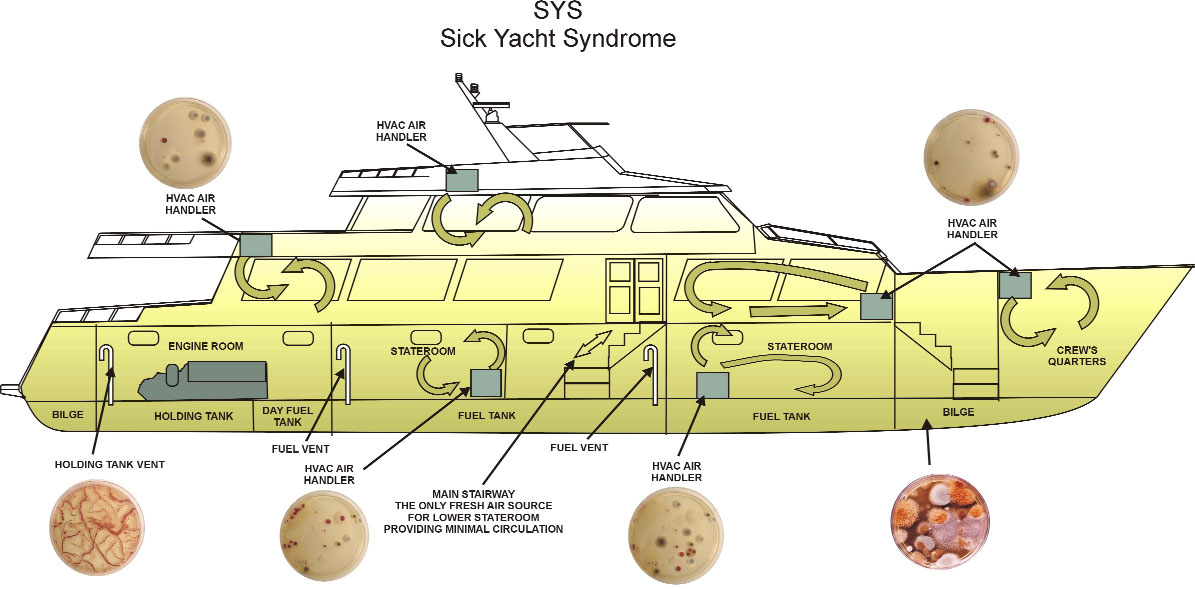
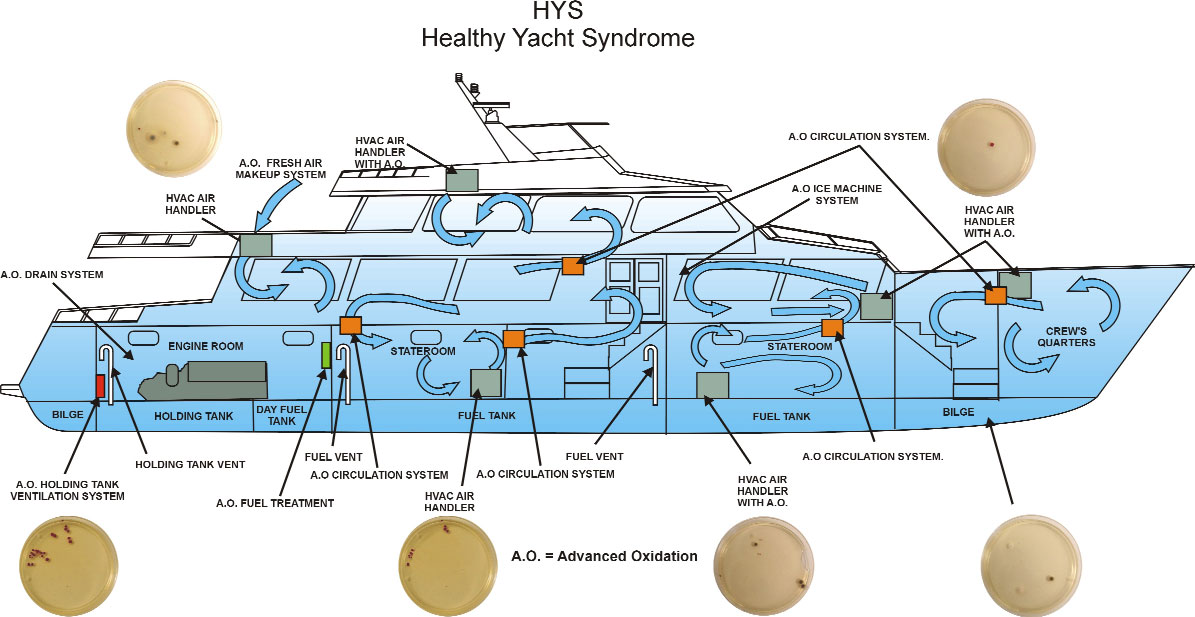
Therefore heating, ventilation and air conditioning (HVAC) equipment is kept to a minimum. Make-up air or fresh outside air is limited or non-existent.
Make-up air should represent 25% of a yacht's airflow. Designers prefer to recycle air as it is usually warmer or cooler than outside air, so less energy is required to heat or cool the air. The problem is you are continuously turning over the same air. This is especially true in the lower staterooms. Assuming no one opens a port hole and each stateroom has its own air handler (heating/cooling unit) and two people are in a stateroom with the door closed, there is no fresh air circulating, just recycled air. This is true for the entire lower stateroom area. The only way to get fresh air is down the stairway via Brownian motion or a very slow molecular air transfer. Trying to get fresh air down a stairway into closed staterooms is like trying to blow air into a bottle. The old air has no place to go so you end up with a static air situation. With all the airborne bacteria, molds, yeasts and VOC's, this build up can cause very serious problems. Most bacteria are harmless, but when you have a build up of billions, you drastically increase your chances of exposure to a bad one.
Diesel Fuel. A yacht can carry anywhere from a few hundred to tens of thousands of gallons of diesel fuel. The fuel, of course, is confined to the fuel tank. Most yachts have a diesel fuel odor. Some are subtle, some are stronger. Assuming there are no leaks or spills, you will still get diesel odors from the fuel tank vents that relieve air pressure caused by fuel displacement of air and temperature variations. Fuel vents vent outside the boat. However, some diesel odors always seem to find their way inside the yacht, plus the engine room usually has lots of small leaks and venting. Why is this important to the yacht owner's indoor air problems? Aside from diesel fuel odor being unpleasant, diesel fuel is a microbial breeding ground and food source. Diesel fuel has the ability to harbor and grow 30 types of bacteria, 12 yeasts and over 80 fungi species. When fuel odors are present, these odors actually represent minute aspirated fuel particles that could easily be carrying some of the bacteria, yeast or fungi known to grow in diesel fuel.
Bilge odors. All yachts have bilges, and with them come odors, oil, fresh water from air conditioner condensers, and soapy wash water. All are excellent breeding grounds for bacteria. Oil, like diesel fuel, contains bacteria, yeast and fungi. Soap and detergents contain phosphates, a fertilizer for our lawns and gardens and also fertilizes microbial growth. As with diesel odors, bilge odors aspirate minute particles of bilge water loaded with microbial and food sources for the microbials.
Holding tank odors. Yes, sewage stored in a yacht holding tank can run from 50 gallons to over 5,000 gallons. Again, these tanks are vented outside of the hull, and are a huge source of bacteria, viruses, methane, and hydrogen sulfide gases, and of course, odors. These sewage gases, bacteria and odors always seem to find their way into the yacht, again providing microbials as well as food sources for the
microbials themselves.
Wastewater Related Diseases and Viruses from Inhalation*
- Tuberculosis
- Histoplasmosis
- Coxsackie A&B
- Adenovirus
- Bacteria Dysentery
- Common Cold
- Echovirus
- Rotavirus
*Water Pollution Control Federation
Molds are gaining worldwide attention. Multimillion dollar homes are being razed due to mold contamination. Insurance companies are excluding mold damage from their coverage. Mold spores are everywhere. All they need to grow is still air, moisture and a food source. Yachts provide a perfect atmosphere for growing mold. Ideal food sources are leather, paper, fabric and wood. This combined with stagnate air and dampness produces a perfect mold farm.
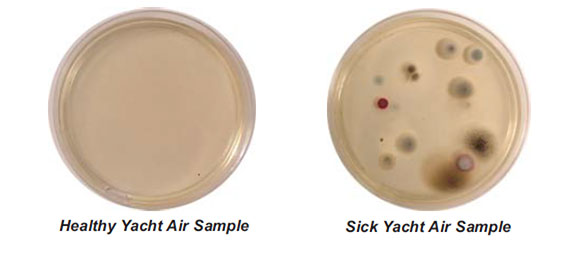
VOC's or volatile organic compounds are a common indoor air problem as they are everywhere: cleaning compounds, plastics, furniture, etc. All are found on a yacht. However, a yacht will have much higher levels of VOC's then a home due to all the glues, sealants, oils and fuel, and a fiberglass vessel will be continuously off gassing VOC's.
Lysteria is a unique strain of bacteria that can live in a very cold atmosphere and is often found in sink and shower drains and ice makers. When food poisoning breaks out in a restaurant and nearly everyone gets sick, it is usually from the ice machine lysteria bacteria. Most patrons are served ice and water or ice in a drink. Lysteria loves yachts - lots of ice machines, lots of drains and shower sumps to grow in. Drains, shower sumps and heads also add to the yacht odor and overall bacteria problems.
Norwalk Virus represents a very serious problem to the cruise and yacht industry. Thousands have been infected and many cruises cut short. Why is Norwalk so prevalent on a ship? Norwalk is most likely transferred by confined environment and surface to hand contact. It is very difficult to contain. Disinfect surfaces or wash your hands frequently.
Staph Bacteria. There is a strain of staph that is frequently and accurately reported by the media as flesh-eating bacteria. The wounds are black, and it literally digs a hole into your flesh. The full name is streptococcal bacteria and it does eat flesh. There have been an unusual number of cases on yachts.
Why yachts again? They are ideal breeding grounds for microbials and the higher number you are
exposed to the harder time your immune system has fighting them off and the higher the odds are you will be exposed to a dangerous microbial.